The Stone Garden: Meditations on History, Experience, and the Nature of the Mystical
The Stone Garden: Meditations on History, Experience, and the Nature of the Mystical
The texts are tales of “passions” of and in history.
— Michel de Certeau, The Mystic Fable
Gardens abound in the Persian poetic imaginary and have been the site of symbolic overdetermination for more than a thousand years.[1] Unlike the classical gardens of (other)wordly desire, however, there is a garden that resists domestication to the allegorical order: the stone garden is no self-contained utopia onto which our own longing for shelter from hostile forces can be projected. Instead, it stands as a sacrificial dance frozen in time, memento to an individual passion and the ravages wrought by history on a subject without voice.
•
Some years ago, maybe five or six, a friend shared a short clip with the laconic description “dancing dervish.” The images of a gaunt man performing a strange dance among the skeletons of stone-bearing trees impressed themselves on my mind. What was the meaning of the dance? I kept returning to the clip in the hope of decoding its meaning, but the dance retained its hermetic aura. In all my time of thinking about music and embodiment in Sufi practice I had never come across anything like it, yet I sensed that the old man’s dance was not incidental: there seemed to be a woundedness at the origin of the dance that extended beyond the filmed moment itself.
Who was the man and why was he dancing? Were the dead trees in his garden of stones devotional objects or, rather, symbols linked to the obscure ritual of an absent community? Why was there no sound to the dance except for an irregular drumbeat and an ominous electronic noise that had been laid over the moving images? Writing in the fourteenth century, Rumi’s hagiographer Aflaki traces the origin of the Mevlevi dance to a moment of loss when he recounts that Rumi “instituted the sama” — the ceremony of whirling communion — after the disappearance of Shams-e Tabrizi “on Thursday the 21st of the month of Shavval in the year six hundred and forty-two” (March 29, 1245).[2] For Aflaki, Rumi’s dance is a work of mourning in which the self is freed of social constraints and the limitations of worldly reason alike. Loneliness and grief did appear to animate the gaunt old man’s dance, yet there was none of the existential comfort that a community of Sufis could have offered. Instead, the garden itself seemed like a work of mourning for an unsaid or unsayable loss. It also seemed strangely exorbitant, like the indictment, mute and defiant, of a transgression. Not so much symbol but index, the rocks in their improbable suspension pointed to a reality that both was and was not part of the garden. Something — an outside — had infringed on the closed order of the trees and made them bear fruits of stone. Yet the connection between whatever experience had given rise to the garden and the fact of an outside beyond it was likely to be nonlinear and complex. An astute historian of liminal figures and spaces, Michel de Certeau in his luminous Mystic Fable shows how the works of the mystics are shot through with history in fundamental and often unexpected ways. He traces with singular force and clarity how the “mystical” emerges at particular moments in time: moments of instability or transition between political orders, experienced by those at the margins of society. Could the dance of the dervish be a manifestation of the historical tectonics that de Certeau locates at the origin of all anagogic phenomena? In other words, did the friction created by the passage of different social structures, institutions, and, ultimately, epistemological orders give rise to a dance that ruptures our carefully assembled interpretative frameworks?
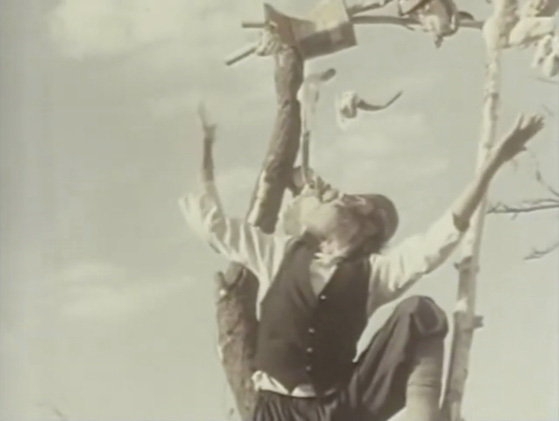
By chance or design, I do not remember, I later found out that the “dancing dervish” belonged to a film — The Stone Garden (باغ سنگی) — by renowned Iranian director Parviz Kimiavi (b. 1939). The film had won the Silver Bear at the Berlin film festival of 1976. All copies I could get my hands on were blurry and in need of restoration — the plight of too many works from outside the Western art circuit. Still, regardless of material imperfections, the story of Darvish Khan Esfandiarpur told by Kimiavi proved as haunting as the dance itself. Deeply political without being partisan, The Stone Garden is a masterpiece of what Hamid Naficy calls the “dissident cinema” of the Iranian New Wave before 1978: it is a profound meditation on history, experience, and the nature of the mystical. Counterpoising surreal images with documentary realism, the film explores the relationship between the mystical and the political, or, more precisely, the shifting hegemonic structures that position an individual in relation to society at large. It asks if the messianic nature of visionary experience is necessarily in conflict with political orders. In other words, is the mystical as expression the symptom of a certain violence inflicted on the subject from outside? With Darvish Khan, the vision itself appears to be parasitic on the encroaching neocolonial system: it is a wound, as it were, of the new order. Darvish Khan’s “passion” tells the tale of Iran at the crossroads of feudalism and state-sponsored capitalism. What follows below are scattered field notes of an approximation to the themes of history, art, and mystic speech at the “moment of danger” (Walter Benjamin) that The Stone Garden captures.[3]
•
With the intensity of his gaze and the eccentricity of his dance, Darvish Khan remains “impertinent to our time,” to paraphrase George Steiner.[4] As I began jotting down thoughts for this paper, I kept coming back to the phrase “dancing dervish” with its anachronistic, somewhat quaint ring. Does “the mystical” always happen elsewhere, I wondered, in the different country that we call the past or, else, in the stricken lands of the Global South? Forever the distant object of study, are the mystics our own Other? It would seem that the appellation of “dancing dervish” laid bare something of the unease with which we approach what we cannot classify or grasp.
The most thorough and profound scholarship, East and West, has been devoted to the great mystics. Their thought endures, beyond its moment of origin, as a legacy of intellectual rhizomes and ritual practices and as a peculiar aesthetic that has held sway over the Persian poetic imaginary well into the twentieth century. However, I kept thinking, the modern mind tends to conceive of “the mystical” as confined to an individual subjectivity untouched by the contingencies of history. With the stone garden, the work itself could not be conclusively explained as the eccentric expression of a pietist imagination. In order to understand, it was important to unravel two questions: How is mystical experience conditioned by an outside that transcends the bounds of the individual “I”? And is mysticism a practice or is it an act of resistance?
Outside the semi-fictional space of Kimiavi’s film, the stone garden is real. It lies in the Iranian province of Kerman, 40 kilometers (25 miles) southeast of the town of Sirjan, close to a village by the name of Balvard. Encompassing 1,000 square meters (10,764 square feet) and some 200 trees, the garden is now a national heritage park and is visited by hundreds of people each year. Darvish Khan Esfandiarpur, the old man of the film, was born on 13th Dey 1303 (January 3, 1925) in Miandoab village, Kerman. It is believed that his grandfather was a powerful tribal leader of the time, hence the title of khan. Darvish Khan himself, while deaf and mute, grew up to be one of the major landowners of Sirjan. He died on 18th Farvardin 1386 (April 7, 2007) and is buried in his garden.
So much for the basic facts of a life that could easily have been lost to the silence allotted to those whom a new order absorbs.[5] Yet Darvish Khan, against the silence, created something that holds out as a monument to the tectonic shifts affecting Iran’s social makeup in the 1960s. Deaf and mute, Darvish Khan could not communicate his experience in words. Had he been able to speak, he might have produced a belated work of mystic vision. Such a work, however, would have been fatally untimely. As the Global South is pushed into synchrony with the social and epistemological orders of the West, the conditions that make mystic speech possible are no longer given. The stone garden does not replace speech. Instead, it is a space where the absence of speech itself is congealed in aleatory stone formations: silent witnesses to an unsayable rupture, the garden’s rocks are suspended from dead trees, as if in a motionless dance, defying the dictates of gravity.
In January 1963, Mohammad Reza Shah launched a series of sweeping reforms that came to be known as the White Revolution. As René Theberge writes, “The central aspect of this ‘White Revolution’ was the land reform program, with its supposed aims of decreasing the inequality of wealth, increasing production through an incentive system, letting peasants own land, and abolishing feudal relationships in the countryside.”[6] In the wake of the land reforms, and along with other major landowners, Darvish Khan lost a great part of his lands. His remaining lands, it is said, were cut off from access to what continues to be the most precious resource in the arid climate of Iran: water. One narrative places the origin of the stone garden in the trauma of Darvish Khan having lost his livelihood to a government policy that enforced radical changes in the name of modernization. Darvish Khan could not speak up and protest. Instead, one narrative goes, he began to collect rocks while herding his sheep in the dry landscape around Balvard. He then went on to hang the rocks from the parched, lifeless trees of his orchard.[7]
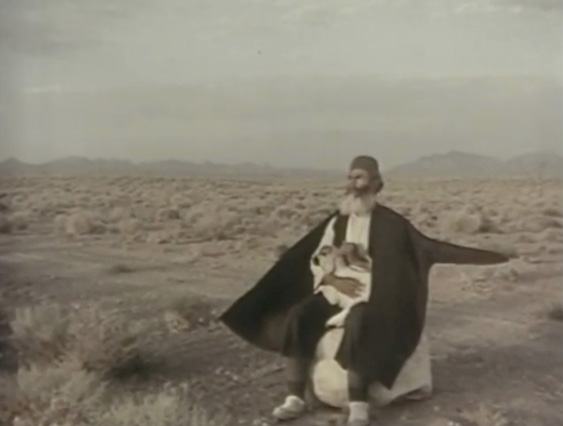
Another narrative, that of the film, attributes a different origin to Darvish Khan’s labors. At point zero, there is a dream: The Stone Garden begins with Darvish Khan out in the open space of the steppe, sometime between night and day, when light and sight are still indeterminate, in abeyance. We do not yet know what happened. After an interlude of domestic life in the family tent, the narration returns to Darvish Khan, who is found asleep, head resting on a rock. His son shakes him awake and Darvish Khan, in mute gestures, tells the story of a vision. How to find images for an event that could have forever stayed hidden in silence? Kimiavi retells the vision in images that are rooted in Islamic iconography, yet go beyond it to lodge a question at the very center of the narrative. In Kimiavi’s rendering, the veil which in medieval Islamic depictions protects the features of a holy figure from our earth-bound human gaze is replaced by a mirror shielding the face. The mirror, however, remains empty, reflecting no object but the rising sun’s glare.

We never learn if the supernatural being of the manifestation corresponds to the Prophet Muhammad or, more likely, the hidden twelfth imam of the Shiites, who will return at the end of his occultation to establish a reign of justice in the world. (Darvish Khan’s wife only speaks of the aqa or “master.”) Identities here do not matter. What matters is the lingering sense of an event as the dreamer wakes from what Hossein Ziai — following Mircea Eliade — calls an “enstatic” dream with its vision of a recognized figure.[8] Islamic mysticism abounds in tales of encounters that come to pass in a dream space of heightened awareness. For Sufis in the wake of Bayazid Bastami, the Prophet Muhammad’s nocturnal ascension becomes the paradigm guiding their own visions of proximity to the divine.[9] Other, less ecstatic accounts tell of a sacred visitation to the “I” in a state of oneiric rapture. Invariably, all of these visions are embedded in “memorial time”: the encounter has always already happened and can only be cast in words once the return to discursive reason — and language — has been accomplished. The divine presence cannot be possessed or retained beyond the time of the dream or vision. Rather, the immaterial trace of a memory is impressed on a material or, more properly, temporal organ: the mind. De Certeau speaks of the mystic’s certitude that something did indeed take place: c’était-là, without doubt. Any attempt to retrieve the original moment is futile. In the end, nothing remains of the vision but this certitude and a memory transmuted into creation: a poem or, words failing, an impossible garden.[10]
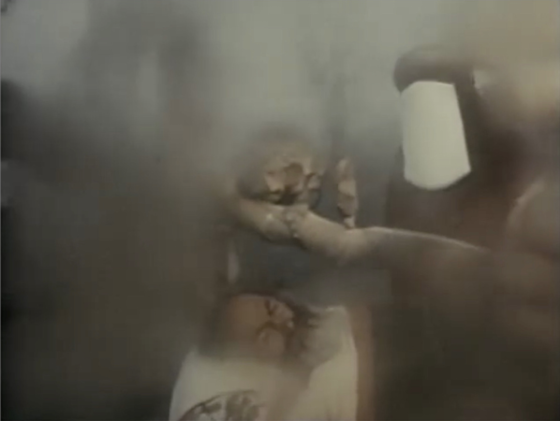
The Stone Garden has been called a documentary, yet it undercuts our understanding of what it means to chronicle or give evidence. What is being documented in the film? Is it a course of events in the life of a “real” figure or an extraordinary occurrence that may or may not have taken place? Like the texts of the mystics, Kimiavi’s film inscribes the laws of time and temporality in unsettling recesses of memory. We will never know the truth of what happened. Darvish Khan remains deaf and mute. Yet, even if he were able to speak, could we trust his words to be adequate representations of an experience that is exorbitant by its very nature? The connection between an experience whose veracity is forever beyond our grasp and the creation of a work that traces itself back to a point zero outside waking reason lies at the heart of the film: What is the role of memory if the event at its origin belongs to a time-space that cannot be reentered? There is a sense of vertigo that arises from contemplating the nonlinear relationship between memory and truth. Neither fiction nor document, The Stone Garden is a reenactment. It re-presents not so much the has-been but the could-have-been at the origin of a creation that has no model or precedent in the Persian poetic imaginary.
A number of seemingly incommensurable epistemological orders are at work in the film, making the ground shift beneath our feet. There is the numinous order of the meteorite that Darvish Khan takes to be a divine injunction, fallen from the skies; the oneiric order of the vision in which Darvish Khan sees the “master”; the sacred order of the garden-as-shrine, exploited, perverted, and monetized almost as soon as it is created; and, finally, the sociohistorical order of neocolonialism, whose human and nonhuman agents are the “outside” which both engenders the garden and threatens its very existence. As in The Cow, Dariush Mehrjui’s 1969 masterpiece, the outside extending beyond the space where the story unfolds creates a sense of threat or unease. In one scene of The Stone Garden, images of marching soldiers are intercut with Darvish Khan’s elder son looking on as the family tent is set up. The outside here seeps in as an effect of policies intended to bring the Iranian tribes and other nonsynchronous social elements into line with a certain idea of progress. Throughout the 1960s and 1970s, a conspicuous military buildup was part of government plans implemented to ensure the political and economic stability of Iran and to attract foreign investment. Early on, in a bid to keep up with the new political will, an efficient conscription apparatus began to extend its operations to the country’s most remote regions. In the drafting of Darvish Khan’s son, we see the ripples of political power struggles being played out beyond the borders of Iran. Some of the most intimate and casual moments are the most telling signs of a new order beginning to take over: the idle circling of Darvish Khan’s son on his motorcycle and his daydreaming the sound of marching soldiers as he watches his father dismantle the family tent. Paradoxically, however, the neocolonial reality does not appear to temper the numinous, oneiric, and sacred orders that make the stone garden readable to Darvish Khan and those around him. The molla despises the garden and considers it blasphemous; the villagers attempt to buy the saint’s favor by attaching money to the dead branches; and the police officer secularizes the garden as a piece of art. Meanwhile, all that could account for the garden’s existence remains hidden away, untouched, as modernity’s Other.
Sounds play a structural role in the film: they both create and differentiate the spaces through which the characters move. One scene shows Darvish Khan climbing the telegraph pole — set up by the government to expand the communication network — before cutting the wire he needs to hang his rocks. We then see a government official climbing down the same pole after the telegraph line has been restored. The soundtracks that accompany the respective ascent and descent are categorically different, as if the spaces inhabited by Darvish Khan and the government agent were contiguous rather than shared.
Another scene shows a public telephone station from where the police officer who had delivered the conscription news to Darvish Khan is trying to reach a colleague in the capital Tehran: “Alo, alo …” (Unnerving connection noise ensues.) “No, he’s not crazy, he’s an artist!” Unlike the villagers, the officer sees Darvish Khan not as a holy man or a fool but as a creator pursuing his unique artistic ideas. He recasts the old man’s vision in secular terms and is moved to a rare act of compassion, attempting to protect Darvish Khan for being an artist. It is a fateful — or auteurial—irony that the telegraph line gets severed almost as soon as the connection to Tehran is established. As Darvish Khan cuts the wire once more to hang his rocks, he takes down the connection that could have saved his son from being called up.
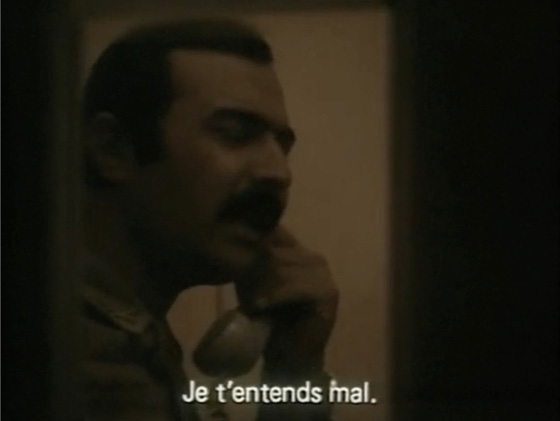
In the absence of any metaphysical transcendence, the artist becomes a secular visionary. Hölderlin, van Gogh, and Artaud are deprived of the certitude that would root their experiences in the comfort of a metaphysical guiding principle. The modern mind knows but the fault lines of madness and art, folding into each other. Fools of God no longer exist and Darvish Khan, once more, appears “impertinent to his time.” Kimiavi, however, does not fall into the trap of a false binary that pits reason and enlightenment against divine inspiration and archaic piety. Instead, he withholds judgement and keeps our perception suspended: The Stone Garden foils official demands for a disenchantment of the sacred in the name of modernity. For Kimiavi, morals are as troublesome as guilt while innocence cannot be mapped onto sides. In one scene that recurs several times, Darvish Khan’s visitors (molla, policeman, and government official) engage in endless exchanges of phony pleasantries “while the ground underneath them literally spins.”[11] There is no innate or a priori moral difference between the representatives of the old and new orders. The villagers are both desperate and full of greed; still, it is Darvish Khan’s wife herself who initiates the garden’s monetization by making the indigent believe that the saint would grant miraculous alms. Ultimately, no one in the social setting around Darvish Khan follows anything but his or her own superstitions.
Mircea Eliade writes that “by manifesting the sacred, any object becomes something else, yet it continues to remain itself, for it continues to participate in its surrounding cosmic milieu.”[12] The unease that the stone garden elicits has to do with our modern urge to divorce art from its sacred origin. We are no longer able to perceive objects in both their material reality and their transcendental significance. Darvish Khan defies the categorization of his work into artistic or sacred, as if the garden were, so to speak, a transcendental materiality: the site of a hierophany but also that of a passion, in and of history. Fully aware, it would seem, of his actions, Darvish Khan resists — in equal measure — the molla wanting to steal a rock to mutilate the sacrilegious garden, the villagers turning the garden into a shrine of their own misery, and the government agents whose speech has been emptied of meaning. Both relic of a fugitive vision and record of a human experience without words, each hanging rock is the token of a memory: the sacred witness to a moment of joy or grief, rooted in time.[13]
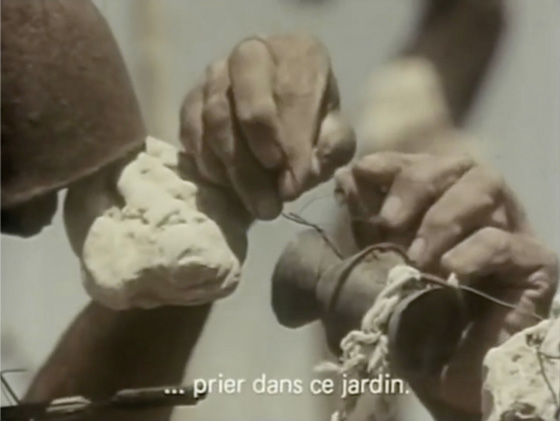
At certain instants, Darvish Khan’s now is juxtaposed with the anticipation of a future that seems ineluctable. However, all such auguries end up unfulfilled or derailed: the future arrives differently. It is not the elder son who dies during military service. Instead, as we learn almost twenty years later, the younger son will die, the victim of a tractor accident at the age of twenty-five.[14] In one scene, Kimiavi intercuts the sacrificial slaughter of the rooster with the arrival of the officer who has come to call Darvish Khan’s son up for the army. Darvish Khan smears blood on the rocks that hang from the trees before standing to attention with bloodied hands. There is a strange dissonance between the slaughter itself—the archaic practice of propitiating God so that the future may take a more felicitous course—and the gaze that falls on Darvish Khan after the sacrifice. To our shelterless and disenchanted modern eyes, the tragic futility of the act is revealed. Yet, as always, Kimiavi does not judge. Instead, a subtly ironic smile unmasks the fundamental absurdity of appealing to God in the face of secular authority exercised by a twentieth-century government apparatus.
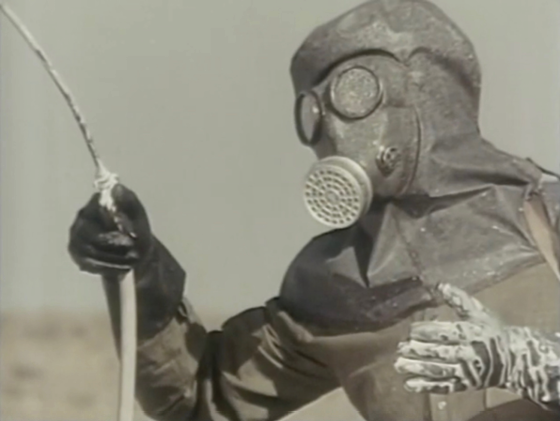
In the final scene, men wearing gas masks attack the trees of the garden with a white substance. The surreal images both preclude reality and heighten it to an extreme level of pain. Is the orchard being destroyed by insecticide, in what may be a reference to the progressive industrialization of agriculture under Mohammad Reza Shah? Or are we faced with an act of chemical warfare, in prescient anticipation of future events in the Iran-Iraq war? The scene is overlaid with what seems to be a horrifically distorted connection signal: a sound of desperation, of speech brought to an end as the wire snaps, and of thwarted hopes that the Other can still be reached. There is no escape from the banal brutality of an act without sense. Finally, at the polar end of zero, the revolving agents freeze, immobilized, intercut with images of Darvish Khan mourning his garden before he hangs himself upside down, a martyr of history, an inverted Hallaj.[15]
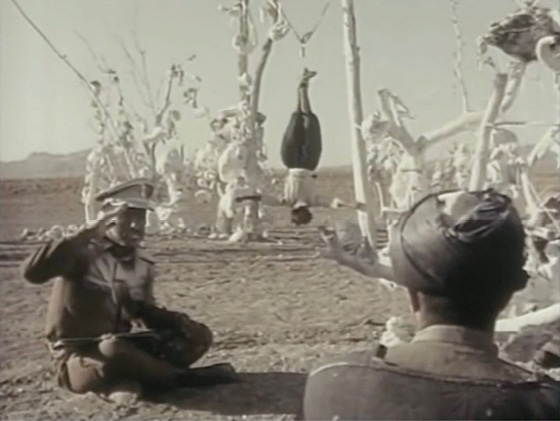
endnotes
The author would like to thank Mr. Morteza Saeedi, without whose help some sources would have remained inaccessible.
-
Literature on Persian gardens is abundant. Important studies include Elisabeth B. MacDougall and Richard Ettinghausen, eds., The Islamic Garden (Washington, DC: Dumbarton Oaks: Trustees for Harvard University, 1976); Julie Scott Meisami, “Allegorical Gardens in the Persian Poetic Tradition: Nezami, Rumi, Hafez,” International Journal of Middle East Studies 17, no. 2 (May 1985): 229–60; and, more recently, Maria Subtelny, Le monde est un jardin: aspects de l’histoire culturelle de l’Iran médiéval (Paris: Association pur l’avancement des études iraniennes, 2002) ; Dominic Parviz Brookshaw, “Palaces, Pavilions and Pleasure-Gardens: The Context and Setting of the Medieval Majlis,” Middle Eastern Literatures 6, no. 2 (2003): 199–223; and Mohammad Gharipour, Persian Gardens and Pavilions: Reflections in History, Poetry and the Arts (London and New York: I. B. Tauris, 2013). ↩
-
Shams al-Dīn Aḥmad Aflākī, The Feats of the Knowers of God (Manāqeb al-ʻārefīn), trans. John O’Kane (Leiden: Brill, 2002), 65–66. ↩
-
Walter Benjamin, in Illuminations, ed. Hannah Arendt, trans. Harry Zohn (New York: Harcourt, Brace & World, 1968), 255, writes: “To articulate the past historically does not mean to recognize it ‘the way it really was’ (Ranke). It means to seize hold of a memory as it flashes up at a moment of danger.” ↩
-
George Steiner, Language and Silence: Essays on Language, Literature, and the Inhuman (New Haven, CT: Yale University Press, 1998), 353. ↩
-
See Michel de Certeau, The Mystic Fable, vol 1: The Sixteenth and Seventeenth Centuries, trans. Michael B. Smith (Chicago: University of Chicago Press, 1992), 84–85. ↩
-
René Theberge, “Iran: Ten Years after the ‘White Revolution,’” Middle East Research and Information Project 18 (June 1973): 11. For an early analysis of the land reforms, see Ann K. S. Lambton, The Persian Land Reform, 1962–66 (Oxford: Clarendon Press, 1969); other relevant studies include Eric J. Hooglund, Land and Revolution in Iran, 1960–1980 (Austin: University of Texas Press, 1982); Grace E. Goodell, The Elementary Structures of Political Life: Rural Development in Pahlavi Iran (Oxford: Oxford University Press, 1986); and Keith S. McLachlan, The Neglected Garden: The Politics and Ecology of Agriculture in Iran (London: I. B. Tauris, 1988), which offers an extended analysis of how the agricultural changes in the Pahlavi era affected the natural environment and disrupted the stability of agricultural cycles, including those related to water supply (see, above all, chapter 5). ↩
-
See Ahmad Talebi-Nezhad, Be revayat-e Parviz-e Kimiavi (Tehran: Hekmat, 2019), 141, 150. The chapter on The Stone Garden sketches the historical background and contains Kimiavi’s own account of how the film was made. While the book’s editor reiterates the narrative that traces the garden’s creation back to the land reforms of the White Revolution, Kimiavi himself chooses to keep the point of origin shrouded in a certain ambiguity. ↩
-
Hossein Ziai, ““Dreams and Dream Interpretation,” in Encyclopaedia Iranica, VII/5, 549, available online at https://referenceworks.brillonline.com/entries/encyclopaedia-iranica-online/dreams-and-dream-interpretation-COM_8546?s.num=0&s.rows=20&s.f.s2_parent=s.f.book.encyclopaedia-iranica-online&s.q=dream. There is a rich literature on dreams and dream interpretation in Islam. Notable overviews include Gustave E. von Grunebaum and Roger Caillois, eds., The Dream and Human Societies (Berkeley: University of California Press, 1966); Özgen Felek and Alexander D. Knysh, eds., Dreams and Visions in Islamic Societies (Albany, NY: State University of New York Press, 2012); and Elizabeth Sirriyeh, Dreams & Visions in the World of Islam: A History of Muslim Dreaming and Foreknowing (London: I. B. Tauris, 2015). ↩
-
Michael Sells, trans. and ed., Early Islamic Mysticism: Sufi, Qurʾan, Miʻraj, Poetic and Theological Writings (Mahwah, NJ: Paulist Press, 1996), 47. Sells writes that “the Mi‘raj, Muhammad’s ascent through the seven heavens to the divine throne was paradigmatic for Sufi understandings of their own mystical journeys. Even when Sufis are not alluding to the Mi‘raj openly … Muhammad’s ascent was a continual subtext, evoked by subtle allusions to inspiration, vision of the divine, and the gaze of the contemplator.” ↩
-
Michel de Certeau in Le lieu de l’autre, histoire religieuse et mystique (Paris: Gallimard Seuil, 2005), 330, speaks of “des expressions débordées par l’excès d’une présence jamais possédée.” ↩
-
Hamid Naficy, A Social History of Iranian Cinema, vol. 2, The Industrializing Years, 1941–1979 (Durham, NC: Duke University Press, 2011), 389. ↩
-
Mircea Eliade, The Sacred and the Profane. The Nature of Religion, trans. Willard R. Trask (New York: Harcourt, Brace, Jovanovich, 1987), 12. ↩
-
In 2004, Kimiavi revisited Darvish Khan to make a different, more — for want of a better word — conventional documentary entitled The Old Man and the Stone Garden (پیر مرد و باغ سنگی اش). It is in the later film that we learn about the meaning of the stones. See also Talebi-Nezhad, 150. ↩
-
Talebi-Nezhad, 156. ↩
-
Mansur al-Hallaj, famous for his ecstatic pronouncement “I am the Real,” was executed in 922 on charges of blasphemy (claiming divinity and incarnationism). The actual reasons for his execution, however, are likely to do with political power struggles in Abbasid Baghdad. ↩



